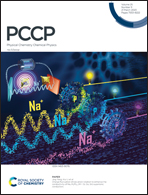Chemical modification of dimethylpolysiloxane for enhancement of CO2 binding enthalpy†
Abstract
The intermittent increase in CO2 concentration in the atmosphere is a serious problem that contributes to climate change; the combustion of fossil fuels produces the majority of CO2, and technology is needed to capture it efficiently. Various CO2 capture materials have been developed so far. Membrane separation, in particular, has an advantage over other capture technologies due to its ease of use. Poly(dimethylsiloxane) (PDMS) has been widely used as a membrane material for CO2 capture because of its high gas permeability. However, despite their high CO2 permeance, PDMS membranes are still in their infancy, especially regarding CO2 selectivity due to the weak interaction between CO2 and PDMS. Here we evaluated the CO2 interaction with the PDMS chain at the atomic scale and attempted to improve the CO2 affinity of the PDMS chain using density functional theory (DFT). Specifically, we substituted elements in the Si–O framework with other elements and substituted the methyl groups with other chemical groups, and incorporated metallic elements such as Mg and Ti. All the chemical modifications by main group elements resulted in physisorption, but chemisorption of CO2 was observed in PDMS incorporating metallic elements. Since several modes of CO2 binding were observed in PDMS with incorporated metal elements, the binding enthalpy and binding mode were analyzed. As a result of various chemical modifications, it was found that introducing earth metal elements into PDMS was the most effective way to enhance the interaction between PDMS and CO2.



 Please wait while we load your content...
Please wait while we load your content...